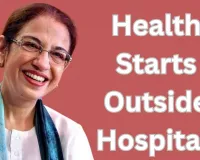Rally Safety and Accountability: Ending Preventable Crowd Tragedies
Digital Desk
.jpg)
The recent deadly crowd crush in Karur, Tamil Nadu, that killed 39 people—including eight children—during a political rally for actor-politician Vijay represents more than a tragic accident . It exemplifies a systemic failure of governance, crowd management, and political accountability in an era of spectacle politics.
As eyewitnesses noted, "Ambulances couldn't get in" and "nothing could be done to control the crowd" . Such tragedies are not inevitable—they are the predictable consequence of inadequate planning, insufficient safety protocols, and the prioritization of political spectacle over public safety.
The Anatomy of Preventable Disasters
Crowd science experts have long understood the mechanics and prevention of crowd disasters. As Professor G. Keith Still notes, most major crowd incidents are "reasonably foreseeable" and preventable with proper crowd management strategies . The primary objective should be "the avoidance of critical crowd densities" and the creation of balanced ingress and egress systems . When these basic principles are ignored, the results are often fatal. The physics of crowd forces becomes terrifyingly powerful—crush forces can exceed 4,500N (1,000 lbs), sufficient to bend steel railings and cause compressive asphyxia, which is the actual cause of death in most crowd incidents, not "trampling" as often reported .
The Spectacle Politics Dimension
In today's highly nationalized political environment, where politics has become a "spectator sport," the spectacle of massive rallies often outweighs substantive governance . Political rallies transform into theatrical events where the appearance of popularity matters more than responsible crowd management. This creates dangerous conditions where, as one witness noted, "Everyone came excited to see a star. What can anyone do if 10, 15 times more people show up than expected?" . The political incentive structure prioritizes massive turnouts over safety, creating predictable tragedies waiting to happen.
A Mandatory Solution: Centralized Oversight and Enforcement
We must advocate for establishing a centralized, non-partisan committee—possibly under the Election Commission or led by retired judicial officials—with authority to mandate and oversee strict crowd control protocols for all large political gatherings. This body would:
- Establish mandatory capacity limits and crowd management plans based on venue assessment
- Require comprehensive emergency plans including clear evacuation routes, adequate barriers, and designated entry/exit points
- Implement pre-event risk assessments and staff training programs specifically tailored for political rallies
- Enforce consequences for non-compliance, including potential disqualification of candidates or parties that repeatedly violate safety protocols
The Path Forward
The technology and knowledge to prevent crowd disasters exist . What has been lacking is the political will and accountability framework to implement them consistently. As we approach future elections, we must demand that our political leadership value human life above political spectacle. Establishing independent oversight with enforceable safety standards would honor those lost in Karur and prevent similar avoidable tragedies. Our political gatherings should reflect our democratic values—not become death traps due to negligence and systemic failure.

.jpg)

.jpg)
3.jpg)



1.jpg)

1.jpg)
